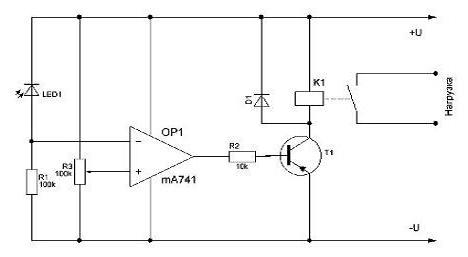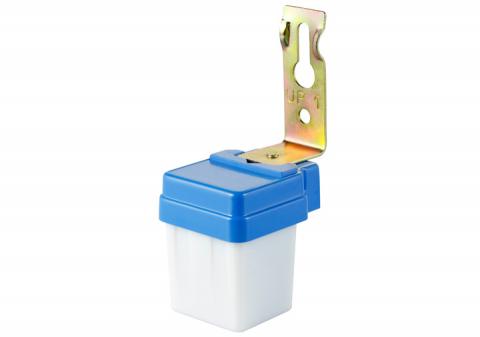Photographic - an integral element of the photoorela, free to turn you on and off the lighting. He will be reasonable to drive them while you will do other important things. How to choose and apply a photo sensor, will be discussed in this article.
Content
Types of photo sensors. Principle of operation
Visually, the photo sensor reminds LED: both in one and the other there is a transparent case, and if it is not transparent, then it provides a window, both in stock collector, emitter. Customize the sensor on ultraviolet or infrared waves, and if quite accurately, then by one wavelength of these spectra. The circuit for controlling the lighting with the inclusion of the photo sensor is called photoelele.
With a street lighting device, a photo sensor is used in 2 versions:
- built-in. This denotes that all the device, the task that control the lighting is mounted outside the house, i.e. outside;
- remote. The photo person is placed outside the house, and the electronic unit is located on the panel in the house.
Lighting photo sensors are working according to the following principle: with the onset of twilight, phototransmistory resistance is growing and the lighting turns on. With the sunrise, the process is repeated, but already in reverse order.
Ways to connect photoators
Installation methods only 2:
- if the lanterns in your yard have personal meals, then the photo sensor will have to be installed on each. The synchronicity of the lighting on the light will depend on the location of the lamps. If one lamp under the tree, and the other in the open plot, then simultaneously they will not turn on;
- in the case when there is one power source for all lamps, it is enough to install a photo sensor on one of the lamps. As soon as the time is suitable, it works and all other lighting devices running from the general source are included.
Choose photoatchik
The market offers a large selection of lighting elements, but to buy a photo sensor, the price of which will arrange you, and the effectiveness does not suffer from this, it is necessary to know anything about them.
Requirements for remote photo sensors
A remote photo sensor is applied in relays that cannot be installed on the street, so the photo sensor is operated on the street separately. Naturally, in such conditions, a number of requirements are presented to it:
- the presence of a strong, hermetic case is necessary;
- the degree of protection of the hull is high. The work of the photo sensor should not influence the weather conditions;
- potentiometer and protection against false positives - mandatory elements of the remote photo sensor.
Example of a remote photo sensor in the AWZ-30-10 / 38 relay from the Belarusian company Euravtomatics F & F:
- it is powered by a 220 V socket;
- time from inclusion before executing the command from 5 to 15 seconds;
- it turns off with the delay of seconds 20-30;
- consumes 0.85 W;
- has a degree of protection IP20;
- works in the temperature range from -25 to +50 degrees C;
- designed for without problematic operation for 100,000 cycles;
- Install the photo sensor is necessary so that it does not shine directly turned on the lamp.
Photodmitchik FD - 3 - 2
The photo sensor is used as remote in the FR-M01-15 photorele from the Russian Electrotechnical Company Meandr. This photowork is different:
- the presence of 2 subbands of the control level of the level of illumination. To select a range, between the terminals "Y1" and "T2" is installed jumper. The 1st suggestion is the illumination of 0.5-30, and the second from 3 to 300 suits;
- it is fixed on the shield or on a flat surface. Moreover, for the second embodiment, the FD bracket is provided. Figure 2 in the designation determines the length of the wire. It is equal to 2 m.
Simple photo sensor in photoele LXP-03
In its own area to control the level of illumination, a simple simple photo sensor is quite enough. An example of a photo sensor in the lighting control circuit through the LXP-03 photoLEL:
- turns on at maximum light 15 lux;
- has a high degree of protection - IP44;
- this illumination detector is manufactured by Feron, which is located in China.
We make a photo sensor for street lighting themselves
A person is more or less versed in electronics, can make a photo person with his own hands. Consider the simplest scheme: 
Details here are a bit:
- used OU-type K140UD6 or other similar type, as a comparative device;
- lED1 photodiode;
- resistors.
The scheme works as follows:
- when the level of illumination drops, resistance is growing on the LED1 LED;
- on the R1 resistor, the voltage drop, on the contrary, decreases, therefore there is a decrease in the voltage drop from the inverting input of the OP1 operating amplifier;
- r2 resistor - threshold. It sets the voltage level at the input of the non-interventication of the operating device;
- the K1 relay turns on at a voltage in the inverting input, the value of which is less than the threshold causing high voltage values \u200b\u200bat the OR1 output.
Favorable tandem: photo sensor + motion sensor
Solving the photo sensor to buy and install, you get rid of the duty to include and turn off the illumination of your garden and the yard, but some problems will appear:
- First, the lamps will consume electricity all night! Does it always need it? From the point of view of finance - very considerably;
- Secondly, even by including a timer in the chain and configuring it so that the lighting will turn off, for example, after midnight, you solve the problem of saving only half.
How to do? So that convenient and not very expensive? The smartest way out is to add a motion sensor to the photo sensor. Now, at night, your territory will dive into darkness at night, but as soon as you try to stroll around the garden or suddenly return home late, in front of you, as in a fairy tale, lights will light up, and you go out - go out. Motion sensors distinguish:
- active. These include ultrasound and microwave sensors. They detect objects in motion using pulses: ultrasound and radio waves, respectively;
- passive. The basis of work is infrared radiation coming from the body of a person or an animal. There is no independent radiation from them, so they were called passive. So that the lighting in the zone is not turned on with each appearance of a cat or other small animals, the sensor is configured on the size.
Look a few useful information on how to install the photoyele and how it works:























